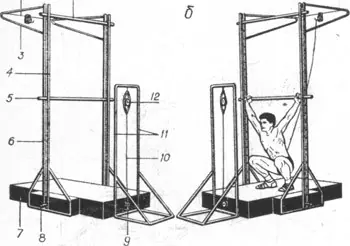We continue our story about what innovative devices are used to carry out the daily training of professional-level weightlifters. In this review we will get acquainted with another interesting training device, actively used by athletes and coaches around the world. In particular, the now famous weightlifters of the People's Republic of China are practicing their weightlifting exercises exactly on this device...
A simulator for improving the technique of weightlifting exercises.
Using the simulator allows you to improve elements of weightlifting exercise technique modern weightlifters using the method of imitation in isometric mode, as well as to analyze the interaction of the athlete with the apparatus in the squat phase when simulating the jerk and push of the barbell from the chest.
The basis of the machine (Fig. 1, a) is a U-shaped frame, welded from pipes with a length of 2450X1050 mm 4, located on a metal base 1050X1000 mm with a height of 150 mm 7. The base of the machine is equipped with a strong ceiling for attaching a wooden flooring 2000 mm long. The upper ends of the pipes are bolted to bar 1 with a length of 1150 mm and a diameter of 30 mm. 30X15 mm holes are drilled at its ends. On the outside of the pipes, tires 6, 25 mm wide, with holes every 50 mm run along their entire length. The upper ends of the tires are located in the guide holes of the upper bar, and the lower ends are attached to the lower bar 8, located at the base of the machine. Dynamometer 12 is connected using an inextensible cable 10 to a bar passed through two rollers 9. The dynamometer is suspended on a special U-shaped stand 11 measuring 1500×50 mm. The middle bar with pipe 5 put on it is located between the guides of the machine and is connected to the tires at any height every 50 mm by means of L-shaped 8 mm metal rods.
To record spatial and temporal parameters, a bracket 2 with an electric switch 3 connected to an electric stopwatch is attached to the upper ends of the guide pipes. A nylon line attached to the athlete's waist belt fits the switch rod. Micro-electro-contacts connected to stopwatches are built into the base of the flooring, as a result of which the speed of the squat under the bar can be recorded.
Working with a middle bar in his daily training, an athlete, focusing on the readings of a dynamometer located in front of his eyes, can accurately determine the force being developed at various key points in the trajectory of the bar’s movement when performing various weightlifting exercises: bench presses, sitting, standing, snatch and push lifts, bending over, squats with a barbell, etc.
In addition, the design of the machine allows you to train muscle strength in isometric conditions, at different joint angles, in different positions, while maintaining a strictly fixed position and strictly dosed effort (Fig. 1, b).
The athlete, stepping on the micro-switch button, stops both stopwatches, and with the beginning of the lift-off from the platform (at the moment of their placement), both stopwatches are turned on. When your feet touch the platform (at the moment of squatting), one of the stopwatches stops, recording the time of the unsupported phase. When the athlete reaches the required depth of the squat, the second stopwatch stops when the fishing line is pulled, recording the total time of the squat.
Post Views: 118


